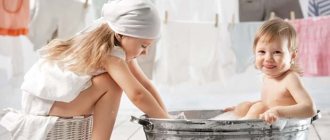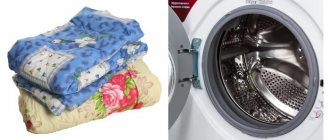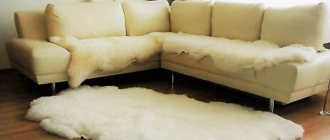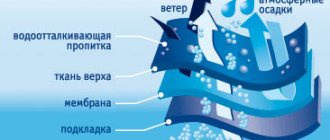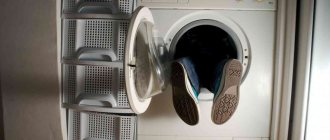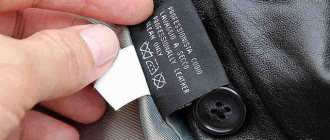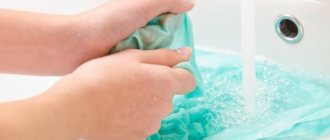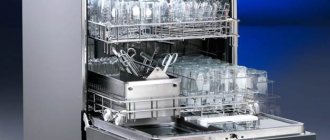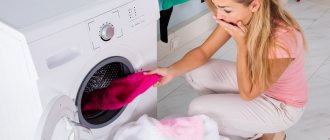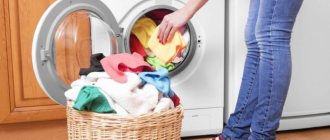Tips for washing clothes for a newborn baby
Everyone knows that washing things regularly is important for your health. This is especially important if there is a child in the house. It should be carefully looked after, because babies have delicate skin and weak immunity. You should start by destroying harmful microorganisms. Of course, today it is much easier to wash thanks to the advent of modern technology, but you still need to take into account several features.
What to choose: machine or hand wash
Household appliances make our lives much easier. Thanks to automatic machines, caring for babies has become easier and more enjoyable. Mothers and grandmothers washed by hand and still recommend this experience to young mothers.
The machine rinses and wrings out clothes better than a human, removing traces of powder without leaving a trace. There is a significant drawback - it is not hygienic. All household items and shoes of family members are processed in the drum. Experts recommend spinning the machine empty or using not very dirty laundry before processing children's clothes.
After the birth of a child, the mother’s main task is to envelop him with care, affection, and provide sterile living conditions. Proper care is an important condition for raising a healthy child. You need to feed, swaddle, and wash properly, otherwise the baby will develop health problems. The immune system is under serious stress, it is important to help the baby adapt as much as possible.
The article has been verified by the editors
Basic washing rules
- Children's clothes should be washed separately from adults. If there is feces on them, you should first wash them off with water, and if necessary, rub them with a brush.
- It is better to wash things right away, as it is easier to put them in order while the dirt is fresh.
- If the clothes are very dirty, it is better to initially rinse them with water and leave them in a soapy solution for at least an hour.
- Be sure to rinse your children's things thoroughly, otherwise the remaining powder may cause itching.
- It is also better to dry children's clothes separately from adults; try to hang them so that dust from the street does not get on them.
- Ironing clothes on both sides is good for disinfection. Ironing is a must.
- It is better to wash mother’s things with special means, especially for women who are breastfeeding.
- Interestingly, the grandmothers believed that during the first month of a child’s life, his urine was clean, so it was enough to just dry the diapers and not wash them. However, it is better not to listen to such advice, but also to remember that there is nothing wrong with clothes washed at the wrong time.
A few tips for drying and ironing clothes
After washing, laundry usually smells fresh and clean, but if you want to enjoy this feeling as much as possible, you will need to fulfill some more conditions.
If you still want to complement the smell of new linen with some aroma, then after drying you can put the linen in the closet with some herbs.
It is not always convenient to iron bed linen, as it is very bulky, which is why we advised not to turn the linen inside out. If you followed our advice, then all that remains is to smooth out some corners and small elements. Be sure to keep the following tips in mind:
- small elements like embroidery should be ironed on the reverse side so as not to damage this element;
- before ironing, it is better to keep the laundry a little damp, this will make it easier to smooth out wrinkles;
- Some materials (for example, silk) need to be ironed in a gentle mode: without steam and at a low temperature.
Do I need to wash new clothes?
There is only one universal piece of advice on how to wash clothes for newborns before the maternity hospital - when washing for the first time, set the maximum temperature allowed for each type of fabric. This will help avoid health problems.
New items must be washed in order to get rid of various contaminants that accumulate on them during the production process. Clothes pass through many hands, lie in warehouses - traces of paint, dust particles, and bacteria remain on them. The newborn’s immunity is not yet formed; protect the child from contact with pathogens.
Many fabrics are treated with chemicals to prevent caking and mold, and starched before sale to give things a presentable appearance. Starch should be washed out of clothes so that it does not irritate the baby’s delicate skin.
How often to wash baby clothes
Focus on the child's age.
- Wash your newborn's clothes as soon as you notice dirt on them. Change your baby's clothes daily. Dress your child in clean clothes after each bath, even if the rompers and undershirts have not gotten dirty during the day.
- Wash your bed linen once a week. More frequent washing is required only if dirt appears on it. Don't hoard dirty laundry - it accumulates bacteria.
- Place clothes for babies older than one year in a separate laundry basket and wash them twice a week. There are no strict recommendations, set a regime that is convenient for you.
When the baby is still “potbellied”
Preparations for meeting a newborn begin long before he is born. Some people believe in omens and leave major purchases for later, while others are ready to fill the house with baby trinkets from the first days of pregnancy. But everyone always prepares clothes for the baby.
Tiny vests and overalls are not enough to buy. New things need to be washed before going to the hospital. The fabrics of new clothes may contain starch (which is added to give the product a better look), and children's clothes should not be worn with starch. The fabric lay in a warehouse, then was in the hands of cutters, seamstresses, packers, resellers and even the most unpredictable people. Be sure to wash it. Strictly speaking, it is advisable to wash any new item in the washing machine after purchase, but definitely clothes for a newborn.
For the first contact of delicate baby skin with clothes, you need to choose only natural fabrics and baby soap for washing. Then we’ll argue which way they make things better - after washing with soap or powder, but for now the expectant mother has time to lovingly wash the “toy” pants with baby soap. It is rinsed worse than when washing with powder, so you need to repeat the rinsing procedure 2-3 times. What kind of water? Flowing and warm.
Ironing washed clothes for a newborn on both sides is not an empty tradition. It is the iron with steam that finally kills possible microbes. Until the umbilical wound heals completely (and this is the first month of the child’s life), it is not recommended to neglect intensive ironing. At temperatures above 100 degrees, all bacteria die. Diapers, clothes (underwear and outerwear) - washed separately, dried separately, stored separately.
Rules for washing children's clothes
To keep your baby's things clean, follow these recommendations:
- Have a separate basket for your baby's clothes, use a separate basin for hand washing, and rinse it regularly with boiling water.
- For automatic washing, choose what to wash your newborn's clothes in the washing machine - powders or washing gels. Make sure that the product does not contain phosphates or bleaches.
- Sort clothes and diapers, load white and colored linen separately.
- Do not accumulate a lot of laundry so that stains do not stick to the fabric; clean them immediately after they appear.
- Load children's underwear separately from adults - there are many harmful microorganisms on the clothes of adults; minimize their contact with the baby. For the same reason, avoid washing heavily soiled clothes in the same machine as you plan to wash baby clothes.
- Do not wash individual stains on children's clothing; send the entire item for washing.
- Rinse rompers and vests thoroughly so that detergents do not cause allergic reactions. Use the “children’s” mode, and if it is not there, double or intensive rinse. If you wash by hand, change the water several times.
- Remove organic waste from the fabric immediately under running water. If the contents of the intestine end up in a pile of laundry, its microflora will transfer to clothing that comes into contact with other parts of the baby’s body. It is not safe.
- Do not use conditioners, stain removers and bleaches containing chlorine, soda, or phosphates. Get rid of stubborn stains with hydrogen peroxide. It also has an antiseptic effect.
- The chosen method determines at what temperature a newborn’s clothes should be washed: for hand washing - no lower than 40 °C, for machine washing - 90 °C.
- Wash the mother's clothes with which the baby is in close contact separately using the same detergents and rinse thoroughly.
- When drying, carefully straighten things to prevent them from becoming moldy.
- Be sure to iron dried laundry on both sides to disinfect it while the umbilical wound has not yet healed.
We recommend reading: The best tablets for children 5 years old - Rating 2020
Manually
Children's underwear and diapers must be washed at maximum temperature to eliminate germs and clean textiles efficiently. Wear two pairs of gloves to protect your hands - cotton and rubber.
Hand wash steps:
- If there are difficult stains, use hydrogen peroxide: moisten the dirty areas with it and rinse.
- Pour water at a temperature of 65-85 °C into a basin, dissolve powder or grated soap in it.
- Moisten individual dried spots, soap, and rub lightly.
- Immerse the laundry in the soapy solution and leave for 15 minutes. If the contamination is severe, increase the soaking time slightly.
- Rub your hands over the fabric, thoroughly removing any stains.
- Rinse things, changing the water several times. Finish with a cold water rinse.
In the washing machine
If you use an automatic machine, look in the instructions on what mode to wash clothes for a newborn, and follow the rules:
- Do not load heavily soiled clothes, rugs, or shoes into this machine.
- Place only children's clothes in the drum, sorted by color.
- Choose a special “children’s” program, which uses a large amount of water when activated. If there is none, run a repeated or intensive rinse.
- Follow the dosage of detergent according to the instructions, do not exceed it.
- Wash diapers and bed linen at 80-90 °C, the rest - at a lower temperature, but not lower than 40 °C.
How to make it easier and more reliable?
But why complicate your life if you have the opportunity to turn to professionals who will remove any stain using modern technologies and products that are guaranteed to be safe for the child? It seems that stains on children's clothes are easy to remove, but this is really true only before the introduction of complementary foods, then it is really difficult to remove them. The cost of dry cleaning for children's clothes is absolutely affordable, and after it the item will be perfectly clean and will last a very long time not only for your baby, but can also be passed on to others, because it will look like new.
Review of safe products for washing children's clothes
The choice of a gentle product for infant linen depends on the baby’s health condition. Any aggressive substances that come into contact with the skin are instantly absorbed. They cause itching, rashes, flaky areas, and redness. The main part of household chemicals releases substances that enter the lungs and bronchi when inhaled. Such exposure can cause weakened immunity and respiratory allergies.
How to wash diapers and undershirts of a newborn so as not to harm his health? The following resources will come to the aid of caring mothers:
- laundry soap, baby soap;
- liquid gel, powder.
Soap
The old version of household soap contains a large amount of alkali and fatty acids. Thanks to these indicators, it has good antibacterial qualities. It cannot be used to wash a child, but it is easy to remove old stains from regurgitation, food, and other complex stains with its help. An obvious drawback is the unpleasant odor, which can be rinsed out and dissipated.
Pay close attention to the composition - there should be no dyes, bleaches, or flavors.
Baby soap is the most preferred product for caring for a baby and his clothes. It contains no dangerous dyes, aromatic substances, or dangerous synthetics. Contains:
- plant extract of string, calendula, chamomile flowers, which have restorative, antiseptic properties;
- boric acid, liquid glycerin, beneficial lanolin, vegetable oil as softeners.
The resulting foam draws out dirt and is then washed out of the fibers.
Disadvantage - it does not give results when removing difficult stains: fruit juice, puree, other food. In the first months of life, the baby secretes drool, milk, urine, feces, which soap can easily deal with if the item is washed immediately or soaked.
To remove stains on light-colored clothing, boric acid, soda, aspirin, and hydrogen peroxide are used. The folk method is safe to use and will not harm the baby. Any natural product is preferable to a chemical one.
Powders and gels
A safe product must have special marks on the packaging. Check that the composition does not contain dangerous substances: chlorine (dries out, causes itching, irritation), phosphate additives (suppresses the protective properties of the skin), optical brightener (is poorly washed out of the fabric, affects skin health).
A-surfactant may be present in a minimal amount.
Popular brands:
- Karapuz. A soap base is used to make it. Hand washing with it is accompanied by a sore throat and nasopharynx.
- Eared nanny. It removes any old stain well, but parents often complain that it causes allergies and itching. It can be used after a year.
- TAID for children. Enriched with chamomile extract, neonogenic, biodegradable surfactants, which is safe for the baby, it contains optical brighteners that leave a pungent odor.
- Stork. Safe powder with a light aroma. Aloe extract has been added to soften the water. You can wash flannel, knitwear, and chintz. Silk and wool products cannot be processed. Of the options presented, this is the safest.
Gels and powders from the companies BabyLine, Amway, Sodasan, Garden, Our Mother are considered popular and safe. The price of the products is high, but it is compensated by the economical consumption.
We recommend reading: TOP 28 best car seats - model ratings, reviews and prices
Useful lifehacks
It's better to start with what you can't do. Do not use substances containing chlorine to bleach children's clothes. Believe me, the baby’s health is much more important than the cleanliness of his socks or undershirts.
Do not use inorganic stain removers for washing children's clothes. If there is a need to use them, you need to apply it pointwise to the stain, and then thoroughly wash the entire item and rinse.
Powders containing oxygen bleach will not harm a child’s skin, but they cannot be called safe either, so you should not get carried away.
Note! Usually, stains from diapers and vests can be removed without the use of chemicals, using safe substances that every housewife has on hand. They will be discussed below.
- To combat serious stains, you need to rub the item with 72% laundry soap and leave it to soak in a basin overnight. After soaking, you can use machine or hand wash. The result will be equally effective, while the laundry soap is safe for health, because it does not contain chemicals.
- How to bleach a vest without using chemicals? It is very simple, just soak it for several hours in water with the addition of soda and ammonia. Add one teaspoon of alcohol and soda per liter of water. After soaking, you need to wash the item using powder or liquid. The composition of this bleach does not destroy the structure of the fabric and is safe for children. Can be used for diapers, rompers and other things.
- A mixture of salt and hydrogen peroxide has similar properties. It is quite simple to prepare a composition designed for 5 liters of water. To do this, you will need to dissolve 50 grams of salt in water and add 2 tablespoons of hydrogen peroxide, as well as half a tablespoon of ammonia. Can be used to soak things in soapy water, this will only make the effect better. After use, be sure to rinse thoroughly.
- To return white items to their marketable appearance, it is better to use boric acid. To do this, add 2 tablespoons of boric acid to 5 liters of water and soak the dirty clothes for several hours. Then do normal washing and thorough rinsing. Socks and stockings will look like they were just bought.
Helpful tips help make life easier for new mothers, but they don’t provide all the answers. That is why the most frequently asked questions with detailed answers are collected below. How to wash and how to bleach undershirts and diapers, do you need to boil them and how long to soak them? You can learn about this and much more now.
The better: top 3 household products
A wide range of washing gels and powders allows you to find among all the variety ones aimed directly at children's underwear. They must have an appropriate indication on the packaging about this.
One of the main requirements is that the selected powder must be phosphate-free.
Video review of baby laundry detergents:
"Eared Nanny"
TM Ushasty Nyan presents a large list of products suitable for washing clothes for children and newborns. The cost of packaging 4.5 kg of powder reaches 1,000 rubles. Gel 1.2 l. – costs about 500 rubles, bar soap – from 35 rubles for 1 piece.
Domal "Baby"
Gel TM Domal is produced in Germany. It is intended for washing clothes of newborns from birth, it is hypoallergenic. The product has passed all necessary inspections and tests confirming the safety of the product. A 750 ml package costs about 500 rubles .
"The world of childhood"
This is natural soap powder produced in the Russian Federation. It is designed for washing clothes of a newborn baby. This is a hypoallergenic product with disinfectant and antibacterial properties.
The powder form is based on natural soap shavings . A gel is also available, the cost of the bottle is 0.75 liters. - about 200 rubles.
Manually
Hand washing should be done at a sufficiently high temperature. You can use hot water at a tolerable temperature or wear two gloves on both hands - cotton and rubber.
Procedure:
- Washing powder or grated baby soap is diluted in prepared water.
- Dip children's clothes into soapy water.
- If there are stained areas on things, they should be treated separately (soap and rub).
- For better washing, it is advisable to soak things for at least 15 minutes.
- Rub your hands after soaking, paying attention to areas with stains.
- Drain the soapy water.
- Rinse things, changing the water at least 3 times.
You should rinse things not in hot, but in warm water. The last rinse is cold.
The spots are coming. And they retreat
When the first complementary foods appear, new worries are added. And if store-bought jars of homogenized puree for babies eliminate the problem of preparing special foods, the mother will have to deal with the stains alone. And there will be spots every day. How to get rid of it?
The main commandment is no chlorine! Any chlorine-based bleach causes allergies in a delicate newborn baby, and this special aroma of bleach is practically indestructible. Also prohibited are any products containing soda and fluorescent substances. They are designed to remain on the surface of the fabric, giving the appearance of whiteness.
The best remedy is hydrogen peroxide. It has a number of advantages:
- safe for the skin of newborns;
- easy to rinse out of fabric;
- removes almost any stain, no matter what its origin, especially if it is not old;
- simultaneously disinfects the fabric from microbes.
At high temperatures, almost all stains also come off. But it is not necessary to boil the laundry, especially since this will turn it grey. A temperature of 60 degrees is already enough.
No matter what ratings you are guided by, the baby will definitely make his own adjustments. Only his sensitive skin is able to choose the right approach to his clothes. Therefore, proceed from the safest means, and from them choose the most suitable one.
In an automatic washing machine: on what mode, at what temperature?
Automatic washing should be carried out on the “Baby Clothes” or “Children’s Clothes” mode. In this case, the temperature is set to the maximum, up to +90ºС, and the rinsing is more thorough than with other modes.
If there is no special mode for children's clothes on the washing machine, you need to focus on the type of material and set the temperature to high. For diapers it is 80-90ºС.
It is also necessary to set up an additional rinse. If the fabric is thin and light, the temperature can be set lower, but not less than +40ºС.
Work order:
- If there are difficult stains on your clothes, it is better to wash them in advance.
- Fasten, if any, buttons on clothes.
- Place items in the washing machine drum. It is advisable that the load is not full - this will allow you to better wash all the products.
- Pour powder or gel into the detergent container.
- Select a mode designed for washing children's clothes. If it is not there, make settings according to the type of fabric.
- Adjust the water heating temperature.
- Set additional rinse.
- Start the washing process.
After the end of the washing cycle, items are hung out to dry without leaving them in the washing machine for a long time.
Features of washing a new set of bed linen
Following the recommendations for processing a newly purchased set of household textiles will help you get the desired result and not eliminate that touch of freshness that is typical for new products:
- Pillowcases and duvet covers should be turned inside out.
- The best option for processing any fabric is hand washing in water at a minimum temperature of no more than 30-40ºС.
- Mixing several sets is highly not recommended; this can only be done if they are absolutely identical.
- Bleaches, stain removers, softeners and color stabilizers are prohibited. It is better to replace washing powder with a liquid analogue. It is recommended to use conditioner while rinsing.
When pre-treating products, there is no need to rub the fabric. It is recommended not to even unscrew it, but only slightly squeeze it with your hands and hang it on the balcony, providing access to fresh air. There is no need to turn things inside out; this can be done in preparation for ironing or after it.
In front of the maternity hospital
When preparing things for the baby before the maternity hospital, you should inspect and wash them. This is necessary both for new things and for those passed down from older children. You can wash the first items by hand or use a machine for this.
To do this, you must comply with all requirements for the care of children's clothing, including:
- washing using products approved for newborns;
- thorough rinsing;
- ironing on both sides;
- storage after processing in a closed cellophane bag.
It is important to choose things made from natural materials, even if they are inferior in beauty to their synthetic counterparts. For the health of the newborn, all products must be made from hypoallergenic materials.
Regular soap
Our grandmothers also washed baby clothes and diapers with soap and hands. True, there were no machines then, and washing powder was difficult to come by. But even now, when stores are full of household “helpers,” there are those mothers who prefer to wash their newborn’s clothes with soap. And there is a reason for this.
The first reason is the minimum of chemicals included in the composition, especially if it is baby soap. Ideally, it does not smell of anything or has a minimal herbal aroma. This means that the soap contains no fragrances or fragrances.
The second reason is the softness of the fabric. A rare powder can wash newborn diapers so that they remain soft and pleasant to the touch. That's why they came up with mouthwashes (which, by the way, cannot be used for a newborn). The soap gives an amazing effect of airiness and softness.
The third reason is the delicate attitude towards fabric. Since baby soap contains a maximum of natural ingredients, it retains the original appearance of clothes longer.
Do new clothes need treatment before wearing them for the first time?
New clothes for a newborn must be washed. Labels, tags and stickers are first removed from them.
Before getting into the hands of a young mother, diapers and baby vests go a long way:
- they manage to be in the hands of those who make fabric and sew clothes, sellers, warehouse workers, and other buyers;
- products may retain traces of dyes;
- many fabrics are treated against caking and mold with chemicals, starch, etc.
To protect the baby, things must be washed and ironed according to all rules. Just as with standard washing of newborn clothes, it is necessary to set an additional rinse.
Types of fabrics for bed linen
A common natural material is cotton. It wicks moisture, breathes, is smooth, pleasant to the touch, and is highly prized. The method of weaving the threads affects the density and resistance to washing. Synthetic additives in bedding are undesirable; it will be difficult to sleep on it. Cotton is used to produce chintz, calico, poplin, and satin.
Chintz is a cheap cotton material, short-lived, budget option for bedding, variegated colors, used for everyday use, quickly deteriorates, fades, and does not keep its shape.
But it washes well and can be boiled; it is used in hospitals, kindergartens, and at home due to its low price.
Calico is a popular type of fabric. Denser than chintz, can withstand up to 300 washes, wears out slowly, and retains bright colors for a long time. The matte surface, high density, and ease of washing and ironing make calico a practical fabric. Not afraid of high temperatures, can be bleached and conditioned.
Poplin - transverse and longitudinal threads differ in thickness, forming a rib. The linen has the properties of calico and has a voluminous woven pattern.
Satin is a smooth, thin cotton material, like satin, pleasant to the body, with a shiny surface due to the double weave of threads. Satin textiles dry quickly, iron perfectly, and are beautifully printed with 3D designs and aristocratic compositions. Satin is more expensive than calico.
Flannel – 100% cotton with original weaving. Fabric with fibers that retain heat is more often used for newborn babies and the elderly. Undershirts, diapers, and underwear made of flannel are soft and are not subject to shrinkage or deformation. If washed incorrectly, pills quickly form. Requires the use of conditioner.
Linen is considered the best material for bedding. Linen is warm in winter and cool in summer. Feature – does not allow dust mites to pass through, inhibits the spread of skin fungus. The price is high. Linen loves cool climates, lasts for many years, and is a practical natural material. One drawback is that it is difficult to iron; wet items are allowed under the iron. In addition to bedding sets, they are used in mattress covers, feather beds, and napkins.
Natural silk is a luxurious, pleasant material. The underwear made from it is exquisite and glides strongly. You won't be able to sleep on silk. Needs delicate washing.
How to remove old stains from diapers
If a newborn stains a diaper or clothes, and the mother forgets to wash and soak them right away, an unsightly yellow mark will form on the surface. It is useless to remove with soap or powder; a homemade recipe will do.
We recommend reading: What is tubing for skating, how is it different from a cheesecake?
Pour into container:
- chlorine-free bleach in the amount of 2 tbsp;
- washing powder ¼ cup;
- high-quality expensive stain remover 20 ml;
- vegetable oil 20 ml.
Pour this mixture with five liters of water, place on the stove, bring to a boil, stirring occasionally with a wooden spatula. Place things in the pan. Hold until the water temperature drops to room temperature. If the mark is old and cannot be removed, leave the diaper in the solution for a day.
This type of washing of children's clothes to remove stains is permitted in isolated situations, strictly for light-colored fabrics. After treatment, wash thoroughly with soap and rinse.
Why iron children's clothes?
The question usually arises from those who perceive ironing solely to remove bruises. But ironing and steaming are one of the means of preventing diseases and maintaining the health of the body.
Beneficial effect on the skin
The skin of a newborn, unlike an adult, is not formed:
- The epidermis consists of only three layers, the rest are formed later. The protective function is weak. Cells are less resistant to the penetration of dirt and infections.
- Unlike adults, newborn skin has a more developed respiratory function. 8-10 times more oxygen enters the child’s body. At the same time there are microorganisms and infections.
- The secretion secreted by the skin has a weak bactericidal effect and therefore does not resist microbial infections well.
- There is practically no excretory function. Sweat glands begin to work after 3 months, and fully - by 3 years.
- Poor synthesis of vitamin D, a substance necessary for a child’s growth and proper formation of bones and muscles.
Based on this, there should be no doubt whether it is necessary to iron a newborn’s diapers. This is a necessary procedure for caring for children's skin. Ironing and steam treatment reduces the likelihood of diseases and maintains the normal condition of the protective cover.
Disinfection and wound healing
It is recommended to iron bed linen, pajamas, and nightgowns after each wash. Dust and dirt are removed with hot water and powder, and some bacteria, linen mites and their larvae may remain on the fabric.
Especially if the wash was in accelerated mode, at a temperature below 40 ° C or together with adult clothes. As a result, the risk for the child’s body increases: microbes provoke internal diseases, bed parasites cause allergic reactions, skin lesions.
Therefore, a hot iron with steam is an effective way to kill larvae and bacteria. In addition, after ironing the fabric becomes softer, less irritating and less damaging to children's skin. Accordingly, it accelerates the healing of wounds and scratches, and prevents the penetration of infections through the pores.
Appearance
After a hot iron, the fibers of natural fabrics are welded together, becoming strong and smooth. Children's clothing is better resistant to dust and microorganisms. In addition, ironed products look more aesthetically pleasing and take up less space on shelves.
Chemicals can lurk in clothes even after washing.
Unfortunately, washing will not remove all chemicals from clothing. For example, the antimicrobial substance triclosan is sometimes added to fabrics, including clothing. Research has shown that triclosan may interfere with hormone regulation and interfere with fetal development.
Animal studies have also raised concerns about its ability to affect fertility, and bacteria exposed to triclosan may become resistant to antibiotics. There have even been suggestions of an increased risk of cancer.
Meanwhile, fade-resistant clothing is a common source of perfluorinated compounds (PFCs), which are toxic to humans and the environment. PFCs are most often heard of in connection with the non-stick properties of cookware, but they are also often found in fabrics.
Unless you buy organic clothing, the clothes sold in stores are made from genetically modified cotton that is heavily treated with pesticides and other chemicals during the manufacturing process.
The Organic Consumers Association (OCA) explains:
“The chemicals used in cotton production extend beyond cultivation. To make harvesting easier, herbicides are used, which cause the plants to shed their leaves - then the boxes are much easier to pick. The process of making textiles from plants uses a variety of chemicals - for bleaching, sizing, dyeing, straightening, anti-shrinkage, stain and odor resistance, fire retardant and antistatic properties, moth resistance, and to reduce wrinkles. Some of these chemicals are applied through a heat treatment that bonds them to the cotton fibers. During the entire process, the fabric is washed several times, but the remaining conditioners and powders are not completely washed out of the final product. Chemicals often used for finishing fabrics include formaldehyde, caustic soda, sulfuric acid, bromine, urea resins, sulfonamides and halogens. Imported clothing is often impregnated with persistent disinfectants (very identifiable by smell) that are very difficult to remove. These and other chemical residues are dangerous for people with multiple chemical sensitivities. In addition, people have developed allergic reactions, such as hives, to formaldehyde due to skin contact with formaldehyde-containing solutions used in ironing clothes.
How to iron children's clothes correctly
Ironing children's clothes will not take much effort and time if you organize the process correctly:
- The workplace should be prepared in advance. To do this, allocate a part of the room for an ironing board near the outlet. Then you won't have to waste time on assembly every time.
- It is advisable to purchase an iron with a steam function and a ceramic sole. With its help, the process of ironing even the most dry clothes will be accelerated, and the gentle coating will protect the material from scorching and damage.
- Diapers, underwear, clothes are sewn mainly from natural fabrics. They wrinkle quickly and often dry out. Before ironing baby clothes for newborns and older babies, they should be sprayed in advance from a spray bottle and left for a while. The fibers will soften and be easier to iron. If the bruises are not very strong, then you can get by with a steam iron.
- If there are no medical indications for ironing on both sides, then older children’s clothes can only be ironed from the inside out.
- To speed up ironing, you need to sort your items by fabric type in advance. The right approach will allow you not to waste time reconfiguring ironing modes.
- Before putting laundry and clothes into the closet, they need to cool naturally.
- Before dressing or swaddling your baby, be sure to let the ironed items rest for 7-10 minutes so that the moisture evaporates.
- You can reduce the operating time of the iron if you start ironing with items made of delicate materials, and then switch to a hotter setting.
Sources
- https://OdmDetka.ru/article/sovety_po_stirke_veshchey_novorozhdennogo_malysha.htm
- https://littleone.com/publication/0-7205-kak-pravilno-stirat-veshchi-dlya-novorozhdennyh
- https://uborkapro.info/stirka-i-himchistka/ruchnaya-stirka/veshhi-dlya-novorozhdennyh.html
- https://yborka.online/stirka/detskie-veshhi/dlya-novorozhdennyh
- https://StiraemDoma.ru/glazhka/nuzhno-li-gladit-veshhi-novorozhdennogo.html
[collapse]
